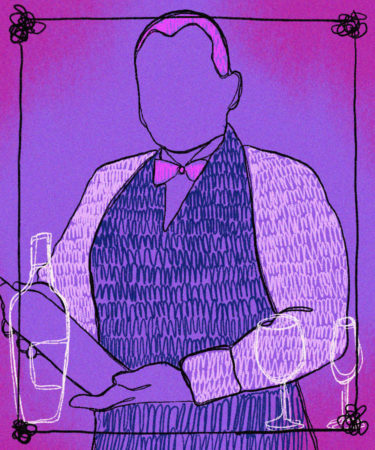
Some drinking fads come and go, while others, such as rosé and the once obscure but now ubiquitous orange wine, are here to stay. With the uncertainty that 2020 has unleashed on the beverage industry, accurately predicting the next wine craze is a daunting task.
To discover which trends could soon be in vogue, VinePair polled industry pros to find the wines and industry practices that they hope will soon gain traction. From an innovative American wine region, to grape varieties and winemaking styles that deserve more attention, here are 12 trends that might be coming to a wine store or restaurant nearby.
The Wine Trends Sommeliers Wish Would Catch On
- Marsalas
- Piquettes
- Screw caps
- Champagne
- Trusting your instincts
- Grosses Gewächs Dry Rieslings
- Coffee shop wine bars
- Selfie-less wine
- North American hybrid grapes
- Labels with technical data
- Transparency
- Rieslings
Keep reading for details about all the recommended trends to watch!
“I like seeing the youngsters drinking their red wines chilled — cold, even. I am [also] happy to see red sparklings gaining a little shelf and cooler space. The thing I have been pushing for the last two years is great Marsala as an indulgence, or a luxury item, instead of a common kitchen ingredient. Marsala belongs in a glass, not on a plate.” —Jeremy Allen, Beverage Director, Little Dom’s & MiniBar Hollywood, Los Angeles
“The making of Piquette. It’s a light, easy-drinking, low-ABV, slightly fizzy wine product made from the grape pomace macerated in water, and traditionally something served to vineyard workers during harvest.” —Damien del Rio, Owner, Sauced, Brooklyn
“I would like [to see] more screw caps and less cork. The sustainability of [the] screw cap is the way to go!” —Lenya Wilson, Level 2 WSET Sommelier, The Glenmark, Glendale, A Tribute Portfolio Hotel, Glendale, Calif.
“Drinking Champagne and sparkling wine for no reason at all.” —Rob Wecker, Master Sommelier and Owner, Bushel and a Peck Kitchen & Bar, Clarksville, Md.
“I wish people would learn to trust people — and their own palates — more than numbers or scores. Trust your instincts about what you like, rather than drinking what someone else thinks you should be drinking. … If you’re really interested in learning about all of the different wines and flavors that are out there, try to pick up at least one new bottle every time you shop for wine. Talk to the people who work at your wine store of choice, whether that’s the grocery store or your local wine shop. Tell them what you usually drink, and ask them to suggest something similar, but different, so you can try something new.” —Shawn Paul, Wine Operations Director, Foxcroft Wine Co., Charlotte, N.C. and Greenville, S.C.
“If there was one trend I wish would catch on, it’s using Grosses Gewächs (great growths) dry Rieslings on wine lists. These are super complex, pair with a range of foods, and, in my opinion, are better pairing wines than white Burgundies.” —Patrick Reno, Beverage Director, Luthun, NYC
“I noticed some new stores combining coffee shops and wine bars. I think those are perfect matches for mornings [that] then roll into a wine bar in the p.m. Both beverages [can be] enjoyed in that setting, doing some work or hanging with friends over some small plates. I think that setup makes wine bars more profitable and helps people learn, with the ability for service teams to talk to their guests. —Luke Kennedy, General Manager, Proper 21K, Washington, D.C.
“Drinking wine without posting a picture of the bottle. If three people drink a bottle of Clos Rougeard together, but no one posts a picture on Instagram, does it still count?” —Jordon Sipperley, Wine Director, Tidbits by Dialogue, Santa Monica, Calif.
“We are seeing a new generation of winemakers in New England experimenting with North American hybrid grapes (such as Frontenac Noir, Marquette, Brianna) — as [opposed] to the vitis vinifera grapes that we all know and love. Female winemaker Deirdre Heekin of La Garagista is a pioneering example of this.” —Kylie Monagan, Partner/Wine Director, Civetta Hospitality (Amali, Calissa, Bar Marseille), NYC and Water Mill, N.Y.
“More technical data detailed on the label. [I] love it when wineries provide information regarding the composition, oak regimen, vineyards, and name of winemaker, grape growers and/or cellar master.” —Scott Lester, Wine Director, Fellow, Los Angeles
“Transparency! By which I mean, simply, putting the ingredients of your wine on the label. It’s such a strange thing that the FDA requires nutritional labels for all packaged food, yet someone can make wine, manipulate it with all sorts of additives and chemicals, and call it Cabernet Sauvignon without listing what they actually put into it. A few wineries in Oregon have started listing their ingredients on the label as a movement to show that they only used organic grapes, for example, or perhaps they had to dilute with water, so water becomes an ingredient. This is a movement about awareness. I think it is a long road to get people on track to really care, but if the wine industry were required to label all ingredients, that might change.” —Austin Bridges, Wine Director, Nostrana, Portland, Ore.
“I wish more people would be open to trying Rieslings. Many sommeliers and wine experts appreciate the qualities of a Riesling because it is such a unique and versatile wine that pairs with virtually any kind of food. … Rieslings offer a fresh new bouquet of flavor to the palate and are really quite unlike any other wines. If you are ‘anti-sweetness,’ which is often associated with so many German Rieslings, stick with dry Rieslings from many New World countries or from Alsace. You will still get the flavor profile but much less sweetness — although sometimes the sweetness really helps when cooling down spicy foods.” —Piero Procida, Food & Beverage Director, The London West Hollywood at Beverly Hills, West Hollywood, Calif.
